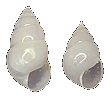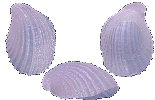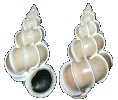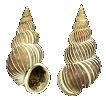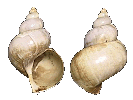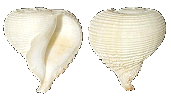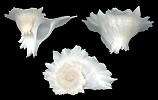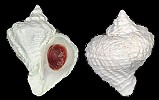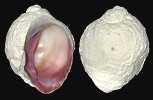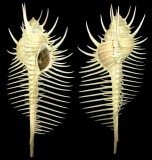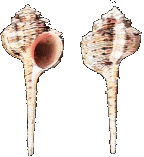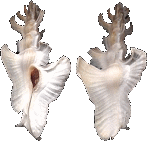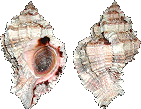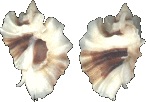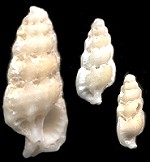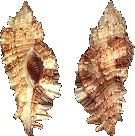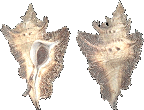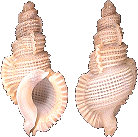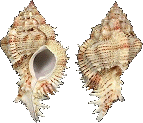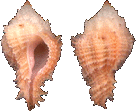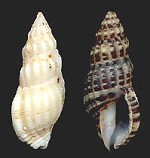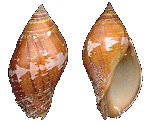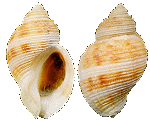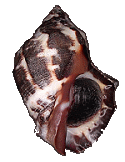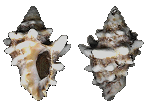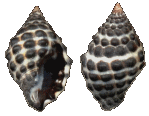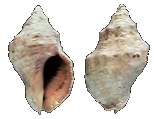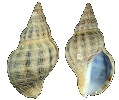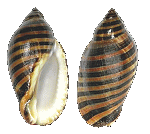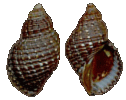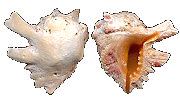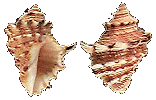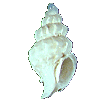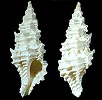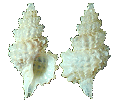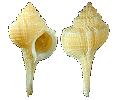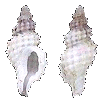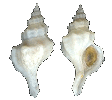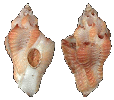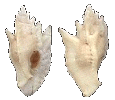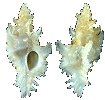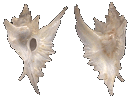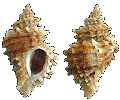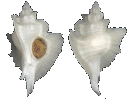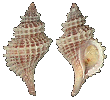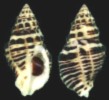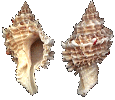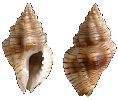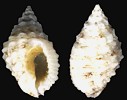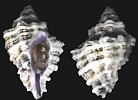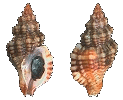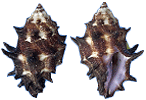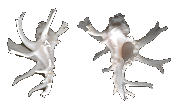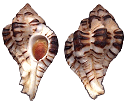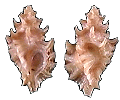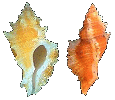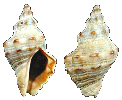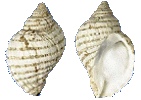2.
Subclass: ORTHOGASTROPODA Ponder & Lindberg, 1996
[= PROSOBRANCHIA Milne Edwards, 1848 p.p. + OPISTHOBRANCHIA;
= AZYGOBRANCHIA Spengel, 1881 p.p.] |
| |
Order:
Hypsogastropoda |
| SubOrder:
Ptenoglossa |
| |
|
SuperFamily:
Triphoroidea
|
| |
Family:
Triphoridae
Molluscs with small and elongated shell. The most evident characteristic
of some species is the left-spiraled shell. |
| |
Incertae
sedis |
| SubFamily:
Triphorinae |
| |
Genus:
Triphora, Triforis, Mastonia, Monophorus, Inella, Viriola,
Mastoniaeforis, Iniforis, Obesula, Litharium, Teretriphora, Cautor, Euthymella,
Isotriphora, Eutriphora, Hypotriphora, Cautotriphora, Magnosinister, Aclophora,
Torresophora, Mesophora, Subulophora, Tetraphora, Nanaphora, Opimaphora,
Liniphora, Talophora, Latitriphora, Nototriphora, Hedleytriphora, Viriolopsis,
Aclophoropsis, Bouchetriphora, Sagenotriphora, Cheirodonta
|
|
|
|
|
|
|
|
Triphora
tubularis
(Laseron C.F., 1958)
6 mm.
|
Aclophora
xystica
(Jousseaume, F.P., 1884)
7 mm
|
Nototriphora
decorata
(Adams, C.B., 1850)
8 - 12 mm
|
Viriola
cancellata
(Hinds, R.B., 184)
8 - 15 mm
|
Monophorus
ornatus
Unknown Author 3.5 mm
|
Mastonia
rubra
(Hinds, R.B., 1843)
to 10 mm
|
|
| SubFamily:
Metaxiinae |
| |
Genus: Metaxia,
Seilarex
|
|
Unable
to locate image
|
|
Metaxia
excelsa
(Faber and Moolenbeek, 1991)
1.3 - 6.2 mm
|
Seilarex
|
|
| Family:
Cerithiopsidae
|
| |
|
Incertae
sedis |
|
Genus: Cerithiopsis,
Seila, Ataxocerithium, Dizoniopsis, Joculator, Eumetula, Zaclys, Specula,
Socienna, Mendax, Altispecula, Pilaflexis, Paraseila, Binda, Euseila,
Conciliopsis, Potenatomus, Horologica, Clathropsis, Synthopsis, Tubercliopsis,
Prolixodens, Sasamocochlis, Belonimorphis, Koilofera
|
|
|
|
|
|
|
Ataxocerithium
serotinum
(Adams, 1855),
to 18mm.
|
Cerithiopsis
flavida
(Golikov et Gulbin, 1978)
4 mm.
|
Joculator
uveanum
(Melvill, J.C. & R. Standen, 1896)
3 mm
|
Seila
adamsii
(Lea, H.C., 1845)
6 - 13 mm
|
Callisteuma
thelcterium
Tomlin, J.R. le B., 1929
|
|
| |
|
|
SuperFamily:
Epitonioidea |
| |
Family:
Epitoniidae
(Wentletraps)
"The Wentletraps, named for
the Dutch word for a spiral staircase, present a surprising array of species,
noted for their intricately geometric shell architecture. Most are distinguished
by a long spire, very deep sutures, and characteristically strong axial
varices that run across all of the whorls from the tip of the spire to the
aperture. The shells are generally white and have a porcelain-like appearance...."
Archerd
Collection |
| |
|
Unplaced
|
| Incertae
sedis |
Genus:
Epitonium, Eglisia, Cirsotrema, Opalia, Amaea, Acirsa, Alora, Gyroscala,
Cycloscala, Punctiscala, Funiscala, Eccliseogyra, Boreoscala, Berthais,
Variciscala, Claviscala, Cylindriscala, Graciliscala, Cirratiscala, Papuliscala,
Gregorioscala, Murdochella, Opaliopsis, Alexania, Chuniscala, Problitora,
Narvaliscala, Plastiscala, Sagamiscala, Kurodacirsa, Narrimania, Periapta,
Minabescala
|
|
|
|
|
|
Epitonium
scalare
(Linnaeus, 1758)
60 mm.
|
Alexania
inazawai
(Kuroda, T., 1943)
8 mm
|
Alora
annulata
(Kuroda, T. & K. Ito, 1961)
12 - 18 mm
|
Amaea
cerea
(Masahito, P., T.Kuroda & T.Habe, 1971)
20 mm
|
|
|
|
|
|
|
Avalitiscala
audouini
(Jousseaume, F.P., 1912)
to 27 mm
|
Cirsotrema
(Cirsotrema) bennettorum
(García, E.F., 2000) 20 - 33.2 mm
|
Discoscala
edgari
(Boury, de, 1912)
to 55 mm
|
Eccliseogyra
nitida
(Verrill, A.E. & S. Smith, 1885)
4 - 10 mm
|
|
|
|
|
|
|
Eglisia
brunnea
(Habe, T. & S. Kosuge, 1964)
30 - 60 mm
|
Lampropalia
enamelis
(Nakayama, T., 1995)
20 mm
|
Mazescala
koyamai
Nakayama, T., 1995
|
Opalia
(Dentiscala) crenata
(Linnaeus, C., 1758)
10 - 25 mm
|
|
|
|
|
|
|
Papyriscala
tenuiliratum
(Sowerby, G.B. II, 1874)
20 mm
|
Parviscala
godfreyi
(Cotton, B.C., 1938)
15 - 25 mm
|
Sthenorytis
pernobilis
(Fischer, P. & A.C. Bernardi, 1857)
to 43 mm
|
|
|
Family:
Janthinidae
(Purple Sea Snail)
"The purple sea snails have
rather fragile, globular shells. The animal has become planktonic, making
no attempt at swimming. They are widely distributed, and along with other
plankton, are swept across the ocean by wind currents. Purple sea snails
rather typically attach upside down to the underside of the hydrozoan, Velella
--a primitive colonial coelenterate resembling the jellyfish-- where they
float and feed on the hydrozoan. If not attached to hydrozoans, Janthina
may also construct a buoyant raft from a tough, transparent, bubble which
it secretes from its foot..."
Archerd Collection |
| |
|
Incertae
sedis |
|
Genus:
Janthina, Recluzia
|
|
|
|
Janthina
(Janthina) janthina
(Linnaeus, C., 1758)
to 40 mm.
|
Recluzia
hargravesi
(Cox, J.C., 1870)
30 mm
|
|
Family:
Aclididae
Molluscswith very small,
fragile shells, with few sculpture and they are sometines transparent. The
Aclidae colonize the muddy bottoms at high depths. |
| |
|
Genus: Murchisonella,
Awanuia, Cyclonidea,Austrorissopsis
|
|
|
Unable
to locate image
|
Unable
to locate image
|
|
Aclis
attenuans
(Jeffreys, J.G., 1883)
2 mm
|
Awanuia
porcellana
(Ponder, W.F., 1967)
to 3 mm
|
Cyclonidea
|
Austrorissopsis
|
|
| |
SubOrder:
Neogastropoda
|
| |
|
SuperFamily:
Muricoidea |
| |
Family:
Muricidae (Murex and Rock Shells)
"Small to large snails -- very few adult species are truly minute
(< 5mm). Most are sculptured with axial and/or spiral ribs, often elaborately
produced into spines, fronds, tubercles, etc. Many groups with prominent
varices. Aperture with or without teeth or lirae; a labral tooth may be
present. Some groups with hollow anal canals, either embedded within the
varix or intervarical. Siphonal canal absent to greatly elongated. Chitinous
operculum present, apex central to terminal...
Digital
Murex- G. Thomas Watters, Division of Molluscs, Museum of Biological
Diversity, Department of Evolution, Ecology, and Organismal Biology, The
Ohio State University
|
| |
SubFamily:
Coralliophilinae
Most of this subfamily are white but some do possess a brilliantly coloured
aperture. These molluscs live in close association with corals. |
| |
Genus:
Rapa, Magilus, Latiaxis, Rhizochilus, Coralliophila , Mipus, Quoyula,
Babelomurex, Hirtomurex, Emozamia, Reliquiaecava
|
|
|
|
|
|
Rapa
rapa
(Linnaeus, C., 1758)
50 - 90 mm.
|
Latiaxis
pilsbryi
(Hirase, Y., 1908 )
22 - 45 mm
|
Coralliophila
(Coralliophila) erosa
(Röding, P.F., 1798)
15
- 35 mm
|
Quoyula
madreporarum
(Sowerby, G.B. I, 1834)
19 - 30
mm
|
|
SubFamily:
Muricinae
"Aragonitic shells, many with a chalky intriticalx. Small to quite
large. Most with prominent varices, often bearing spines or webbing, spines
simple or ramose. Nuclear whorls usually 2 or less in number but with numerous
exceptions. Operculum unguiculate. Central radular teeth generally with
three large cusps and two smaller cusps between them. ..." Ohio
State |
| |
Genus:Murex,
Chicoreus, Hexaplex, Haustellum, Pterynotus, Phyllonotus, Muricanthus, Ceratostoma,
Aspella, Naquetia, Pterochelus, Poirieria, Paziella, Phyllocoma, Dermomurex,
Acanthotrophon, Chicomurex, Attiliosa, Pterymarchia, Ingensia |
|
|
|
|
|
|
Murex
pecten
(Lightfoot, J. in Solander, 1786)
85 - 150 mm
|
Chicoreus
ramosus
(Linnaeus, C., 1758)
50 - 300 mm
|
Hexaplex
cichoreum
(Gmelin, J.F., 1791)
to 150 mm
|
Haustellum
haustellum
(Linnaeus, C., 1758)
103 - 140 mm
|
|
|
|
|
|
|
Pterynotus
elongatus
(Lightfoot, J. in Solander, 1786)
to 90 mm.
|
Phyllonotus
pomum
(Gmelin, J.F., 1791)
to 133 mm
|
Muricanthus
nigritus
(Philippi, R.A., 1845)
133 mm
|
Ceratostoma
foliata
(Gmelin, J.F., 1791) to 85 mm
|
|
|
|
|
|
|
Aspella
producta
(Pease, W.H., 1861)
20 mm.
|
Naquetia
cumingii
(Adams, A., 1853)
to 65 mm
|
Pterochelus
acanthopterus
(Lamarck, J.B.P.A. de, 1816)
90 mm.
|
Poirieria
zelandica
(Quoy, J.R.C. & J.P. Gaimard, 1833)
to 60 mm.
|
|
|
|
|
|
|
Paziella
pazi
(Crosse, H., 1869)
to 50 mm.
|
Phyllocoma
scalariformis
(Broderip, W.J., 1833)
to 38 mm.
|
Dermomurex abyssicola
(Crosse, H., 1865)
10 - 15 mm
|
Acanthotrophon
carduus
(Broderip, W.J., 1833)
20 - 25 mm
|
|
|
|
|
|
|
Chicomurex
superbus
(Sowerby, G.B. III, 1889)
60 - 85 mm
|
Attiliosa
nodulifera
(Sowerby, G.B. II, 1841)
15 - 30 mm
|
Pterymarchia
bibbeyi
(Radwin, G.E. & A. d' Attilio, 1976)
30 - 45 mm
|
Ingensia
bracteatus
(Hinds 1844),
(Houart, 1987)
22 mm.
|
|
SubFamily:
Rapaninae
"Calcitic shells. Small
to fairly large sized, varying from fusiform to very widely ovate.
Typically nonvaricate, but strong axial sculpture may be present.
Sculpture absent, nodulose or spiny, never ramose. Siphonal canal
short to absent, open. Central tooth of radula with 5 cusps (occasionlly
3). Operculum with lateral nucleus. ..."
Ohio State |
|
| |
Genus:Purpura,
Drupa, Nassa, Thais, Nucella, Mancinella, Morula, Rapana, Stramonita, Vexilla,
Vitularia, Pinaxia, Agnewia, Semiricinula, Neothais, Daphnellopsis, Drupina,
Drupella, Dicathais, Habromorula, Phycothais |
|
|
|
|
|
|
Purpura
aperta
Blainville, H.M.D. de, 1832
37 mm.
|
Drupa
rubusidaeus
(Roeding, 1798)
45 mm.
|
Nassa
serta
(Bruguière, J.G., 1789)
50 - 70 mm
|
Nucella
canaliculata
(Duclos, P.L., 1832)
30 mm.
|
|
|
|
|
|
|
Thais
intermedia (Kiener, 1836)
to 42 mm.
|
Mancinella
armigera
(Link, H.F., 1807)
75 mm.
|
Morula
granulata
(Duclos, P.L., 1832)
to 30 mm
|
Vitularia
miliaris
(Gmelin, J.F., 1791)
to 50 mm.
|
|
|
|
|
|
|
Rapana
rapiformis
(Born, I. von, 1778)
76 - 125 mm
|
Stramonita
bitubercularis
(Lamarck, J.B.P.A. de, 1822)
to 50 mm.
|
Pinaxia
versicolor
(Gray, J.E., 1839)
23 mm
|
Agnewia
tritoniformis
(de Blainville, 1833)
20-35 mm.
|
|
|
|
|
 |
|
Semiricinula
chrysostoma (Deshayes, 1844)
30 mm.
|
Vexilla
vexillum
(Gmelin, J.F., 1791)
25 mm
|
Neothais
harpa
(Conrad, T.A., 1837)
35 mm.
|
Habromorula
fuscoimbricata (Sowerby, 1915)
to 25 mm. |
|
|
|
|
|
|
Daphnellopsis
fimbriata (Hinds, 1843)
15 mm.
|
Drupina
grossularia
(Röding, 1798 )
to 28 mm.
|
Drupella
rugosa
(Born, 1778)
20 - 40 mm.
|
Dicathais
orbita (Gmelin, 1791)
60-120 mm.
|
|
|
|
|
|
|
Phycothais
reticulata (Blainville, 1832)
|
|
|
|
|
SubFamily: Trophoninae
"Small to medium sized, usually
fusiform, sometimes greatly so. Aperture usually without teeth or lirations.
Axial and/or spiral sculpture usually present. Species may be spinose, lamellate,
scabrous, or nearly smooth. Many have an intriticalx. Protoconch paucispiral.
Operculum variable. Central radular tooth with five cusps in the few species
studied...." Ohio
State |
| |
Genus:Trophon,
Trophonopsis, Pagodula, Boreotrophon, Axymene, Comptella, Paratrophon, Anatrophon,
Apixystus, Benthoxystus, Enatimene, Enixotrophon, Gemixystus, Litozamia,
Ollaphon, Xenotrophon, Afritrophon, Fuegotrophon, Nipponotrophon, Leptotrophon,
Scabrotrophon
|
|
|
|
|
|
Trophon
geversianus (Pallas, 1774)
30 mm.
|
Trophonopsis
orpheus
(Gould, 1849)
22 mm.
|
Pagodula
pelseneeri
(Smith, 1915)
12 - 32 mm
|
Boreotrophon
stuarti
(Smith, 1880)
47 mm.
|
|
|
|
|
|
|
Paratrophon
quoyi (Reeve, 1846)
14 mm.
|
Apixystus
stimuleus
(Hedley, 1907)
to 3.5 mm.
|
Benthoxystus
columnarius
(Hedley & May, 1908)
to 18 mm.
|
Enatimene
simplex (Hedley, 1903)
to 14 mm.
|
|
|
|
|
|
|
Enixotrophon
carduelis (Watson, 1886)
50-63 mm.
|
Gemixystus
laminatus (Petterd, 1884)
to 7 mm.
|
Litozamia
petterdi (Crosse,
1870)
to 9 mm.
|
Xenotrophon
euschema (Iredale, 1929)
to 21 mm.
|
|
|
|
|
|
|
Afritrophon
inglorius (Houart, 1987)
7 mm.
|
Fuegotrophon
pallidus (King & Broderip, 1832)
(Powell, A.W.B., 1951)
10 - 22 mm
|
Nipponotrophon
echinus (Dall, 1918)
27 mm.
|
Leptotrophon
marshalli (Houart, 1995)
10 mm.
|
|
|
|
|
|
|
Scabrotrophon
lasius (Dall, 1919)
|
|
|
|
|
unable
to locate image
|
unable
to locate image
|
unable
to locate image
|
unable
to locate image
|
|
Axymene
|
Comptella
|
Anatrophon
|
Ollaphon
|
|
SubFamily:Typhinae
"The typhine shell is most peculiar, being characterized by the
presence of a pronounced (sometimes amazingly pronounced) anal tube
that does not arise from the varices, but from the inter-varical area.
Only the last formed tube is functional, the others being sealed off
from the inside. Similar anal tubes may be associated with the varices
of other groups (Ponderia, for example) but these are considered to
be independently derived and not true typhines. Many typhine species
have very smooth or malleated shells giving them the appearance of
being made of plastic or glass. Others are more rugose and a few are
elaborately frilled. They may have quite complicated varices making
it difficult to follow the ontogeny of some species. ..." Ohio
State |
|
| |
Genus:Typhis,
Siphonochelus, Typhina, Typhinellus, Typhisopsis, Tripterotyphis, Monstrotyphis,
Prototyphis, Ponderia
|
|
|
|
|
|
Typhis
belcheri
(Broderip, 1833)
24mm
|
Siphonochelus
japonicus (Adams, 1863)
12 mm.
|
Typhina
cleryi
(Petit, 1840)
15 - 25 mm
|
Typhinellus
occlusum
(Garrard, 1963)
24 - 40 mm
|
|
|
|
|
|
|
Typhisopsis
coronatus Broderip, 1833
|
Tripterotyphis
lowei
(Pilsbry, 1931)
|
Monstrotyphis
montforti
(Adams, 1863)
|
Prototyphis
angasi
(Crosse, 1863)
15 to 25 mm.
|
|
|
|
|
|
|
Ponderia
caledonica
(Houart, R., 1988)
15 mm
|
|
|
|
|
SubFamily:
Ocenebrinae
"Small to fairly large, usually
fusiform, shells calcitic (?). Varices absent or 3-10 in number. Most sculpture,
when present, is scabrous. Although some species are winged as in some muricine
groups, spinose species are rare. Intritacalx usually absent. Nuclear whorls
short, often angulate. Siphonal canal usually closed. Inner surface of outer
lip often denticulate; a few species with labral tooth. Operculum trapezoidal
with lateral nucleus. Radula like that of Muricinae but bearing multiple
minor cusps between the major ones...." Ohio
State |
| |
Genus:Ocenebra,
Ocinebra, Pteropurpura, Vaughtia
|
|
Unable
to locate image
|
|
|
|
Ocenebra
erinacea
(Linnaeus, C., 1758)
20 - 65 mm
|
Ocinebra
|
Pteropurpura
bequaerti
(Clench, W.J. & I. Pérez Farfante, 1945)
to 39 mm.
|
Vaughtia
babingtoni (Barnard, 1969)
14-17 mm.
|
|
|
SubFamily: Ergalataxinae
"Aragonitic shell. 0-2
varices. The central radular tooth has 3 large hook-like cusps between
which is a smaller cusp; laterally are 0-5 smaller cusps as well. Operculum
with sub-lateral nucleus. ..." Ohio
State
|
| |
Genus: Cronia,
Lataxiena, Orania, Maculotriton, Phrygiomurex, Pascula, Muricodrupa, Ergalatax,
Cytharomorula, Spinidrupa, Lindapterys
|
|
|
|
|
Cronia
konkanensis
(Melvill, J.C., 1893)
25 mm
|
Lataxiena
fimbriata
(Hinds, R.B., 1844)
20 - 40 mm.
|
Orania
grayi
(Dall, W.H., 1889)
to 23 mm
|
Maculotriton
serriale
(Deshayes, G.P. in Laborde, L.E.J. & M. Linant, 1834)
11 - 24 mm
|
|
Unable
to locate image
|
|
|
|
|
Phrygiomurex
sculptilis (Reeve, 1844)
|
Pascula
ochrostoma
(Blainville, H.M.D. de, 1832)
11 - 35 mm
|
Muricodrupa
funiculus
(Wood, W., 1828)
25 mm
|
Ergalatax
dattilioi
(Houart, R., 1998)
16 mm
|
|
|
|
|
|
|
Cytharomorula
springsteeni
(Houart, R., 1995)
17 mm
|
Spinidrupa
spinosa
(Adams, H. & A. Adams, 1853)
35 mm
|
Lindapterys
rosalimae
(Barros, J.C.N. de, 1990)
|
|
|
SubFamily:
Muricopsinae
"Generally small, fusiform
or biconic. Sculpture ranges from extremely spinose to nearly smooth. Usually
4+ varices per whorl overlain by spiral threads. Many have an intriticalx.
Radula not flattened but more 3-dimensional. Operculum as in Muricinae...."
Ohio State |
| |
Genus:Homalocantha,
Favartia, Muricopsis, Pazinotus, Pygmaepterys, Xastilia
|
|
|
|
|
Homalocantha
zamboi
(Burch & Burch, 1960 )
60 mm.
|
Favartia
(Maxwellia) gemma
(Sowerby, G.B. III, 1879)
25 - 35 mm.
|
Muricopsis
(Muricopsis) cristatus
(Brocchi, 1814)
10 - 35 mm
|
|
|
|
Unable
to locate image
|
|
Pazinotus
bodarti
(Costa, P.M.S., 1993)
6.5 - 12 mm
|
Pygmaepterys
dondani
(Kosuge, S., 1984)
17 - 25 mm
|
Xastilia
|
|
SubFamily:
Haustrinae
" Medium-sized, rather solid, biconic. Sculpture of axial lamellae
and broad spiral ribs, somewhat chalky. Columella excavated. Outer lip crenulate,
inner surface denticulate. Operculum with marginal nucleus..." Ohio
State |
| |
Genus: Haustrum,
Lepsiella, Lepsithais
|
|
|
|
|
Haustrum
baileyana
(Tenison Woods, 1881)
to 40 mm.
|
Lepsiella
reticulata
(Blainville, H.M.D. de, 1832)
to to 18 mm
|
Lepsithais
lacunosus (Bruguiere, 1789)
18 - 30 mm.
|
|







